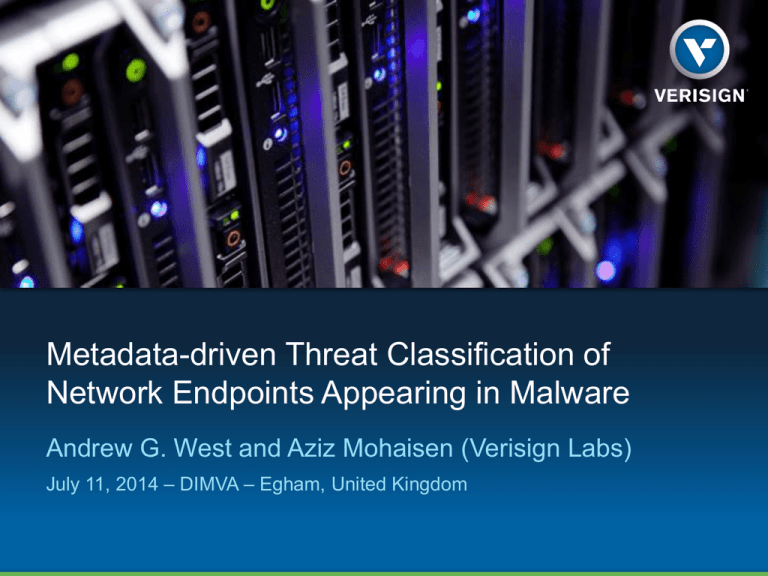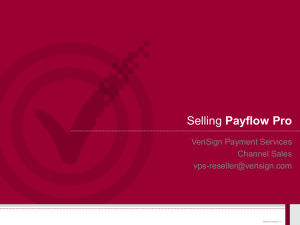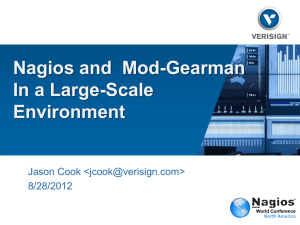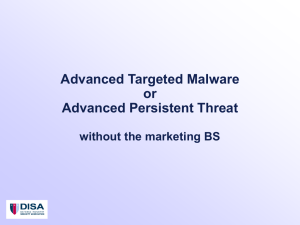
Metadata-driven Threat Classification of
Network Endpoints Appearing in Malware
Andrew G. West and Aziz Mohaisen (Verisign Labs)
July 11, 2014 – DIMVA – Egham, United Kingdom
PRELIMINARY OBSERVATIONS
Program code
Drop sites
x 1000
C&C instruction
1. HTTP traffic is ubiquitous in malware
2. Network identifiers are relatively persistent
3. Migration has economic consequences
4. Not all contacted endpoints are malicious
Verisign Public
2
OUR APPROACH AND USE-CASES
•
•
Our approach
•
Obtained 28,000 *expert-labeled* endpoints, including both
threats (of varying severity) and non-threats
•
Learn *static* endpoint properties that indicate class:
• Lexical: URL structure
• WHOIS: Registrars and duration
• n-gram: Token patterns
• Reputation: Historical learning
•
USE-CASES: Analyst prioritization; automatic classification
•
TOWARDS: Efficient and centrally administrated blacklisting
End-game takeaways
Verisign Public
•
Prominent role of DDOS and “shared” use services
•
99.4% accuracy at binary task; 93% at severity prediction
3
Classifying Endpoints with Network Metadata
1. Obtaining and labeling malware samples
2. Basic/qualified corpus properties
3. Feature derivation [lexical, WHOIS, n-gram, reputation]
4. Model-building and performance
Verisign Public
4
SANDBOXING & LABELING WORKFLOW
AUTONOMOUS
AutoMal
(sandbox)
Malware
samples
PCAP
file
HTTP endpoint parser
Potential
Threat-indicators
ANALYST-DRIVEN
http://sub.domain.com/.../file1.html
Is there a benign use-case?
Non-threat
How severe is the threat?
High-threat
http://sub.domain.com/
domain.com
Med-threat
Low-threat
Verisign Public
Can we generalize this claim?
5
EXPERT-DRIVEN LABELING
•
LEVEL
EXAMPLES
LOW-THREAT
“Nuisance” malware; ad-ware
MED-THREAT
Untargeted data theft;
spyware; banking trojans
HIGH-THREAT
Targeted data theft; corporate
and state espionage
•
Where do malware
samples come from?
•
Organically, customers,
industry partners
•
93k samples → 203k
endpoints → 28k labeled
Verisign analysts select
potential endpoints
•
Expert labeling is not
very common [1]
•
Qualitative insight via
reverse engineering
•
Selection biases
os.solvefile.com
1901 binaries
Fig: Num. of malware MD5s per corpus endpoint
Verisign Public
6
Classifying Endpoints with Network Metadata
1. Obtaining and labeling malware samples
2. Basic/qualified corpus properties
3. Feature derivation [lexical, WHOIS, n-gram, reputation]
4. Model-building and performance
Verisign Public
7
BASIC CORPUS STATISTICS
•
73% of endpoints are threats (63% estimated in full set)
•
4 of 5 endpoint
labels can be
generalized to
domain granularity
•
Some 4067 unique
second level
domains (SLDs) in
data; statistical
weighting
TOTAL
28,077
DOMAINS
high-threat
med-threat
low-threat
non-threat
21,077
5,744
107
11,139
4,087
URLS
high-threat
med-threat
low-threat
non-threat
27.3%
0.5%
52.8%
19.4%
7,000
318
1,299
2,005
3,378
75.1%
24.9%
4.5%
18.6%
28.6%
48.3%
Tab: Corpus composition by type and severity
Verisign Public
8
QUALITATIVE ENDPOINT PROPERTIES
•
System doesn’t care about content; for audience benefit…
•
What lives at malicious endpoints?
•
•
Binaries: Complete program code; pay-per-install
•
Botnet C&C: Instruction sets of varying creativity
•
Drop sites: HTTP POST to return stolen data
What lives at “benign” endpoints?
Verisign Public
•
Reliable websites (connectivity tests or obfuscation)
•
Services reporting on infected hosts (IP, geo-location, etc.)
•
Advertisement services (click-fraud malware)
•
Images (hot-linked for phishing/scare-ware purposes)
9
COMMON SECOND-LEVEL DOMAINS
•
Non-dedicated and shared-use settings are problematic
THREATS
SLD
NON-THREATS
#
SLD
2,172
YTIMG.COM
1,532
NO-IP.BIZ
1,688
PSMPT.COM
1,277
NO-IP.ORG
1,060
BAIDU.COM
920
ZAPTO.ORG
719
GOOGLE.COM
646
NO-IP.INFO
612
AKAMAI.NET
350
PENTEST[…].TK
430
YOUTUBE.COM
285
SURAS-IP.COM
238
3322.ORG
243
Verisign Public
6 of 7 top threat
SLDs are DDNS
services; cheap
and agile
•
Sybil accounts as
a labor sink;
cheaply serving
content along
distinct paths
•
Motivation for
reputation
#
3322.ORG
Tab: Second-level domains (SLDs) parent
to the most number of endpoints, by class.
•
10
Classifying Endpoints with Network Metadata
1. Obtaining and labeling malware samples
2. Basic/qualified corpus properties
3. Feature derivation [lexical, WHOIS, n-gram, reputation]
4. Model-building and performance
Verisign Public
11
LEXICAL FEATURES: DOMAIN GRANULARITY
•
•
•
DOMAIN TLD
•
Why is ORG bad?
•
Cost-effective TLDs
•
Non-threats in COM/NET
DOMAIN LENGTH &
DOMAIN ALPHA RATIO
•
Address memorability
•
Lack of DGAs?
Fig: Class patterns by TLD after normalization; Data
labels indicate raw quantities
(SUB)DOMAIN DEPTH
•
Verisign Public
Having one subdomain (sub.domain.com) often indicates
shared-use settings; indicative of threats
12
LEXICAL FEATURES: URL GRANULARITY
Some features require
URL paths to calculate:
•
•
URL EXTENSION
•
Extensions not checked
•
Executable file types
•
Standard textual web
content & images
•
63 “other” file types;
some appear fictional
Fig: Behavioral distribution over file extensions
(URLs only); Data labels indicate raw quantity
URL LENGTH & URL DEPTH
•
Verisign Public
Similar to domain case; not very indicative
13
WHOIS DERIVED FEATURES
Fig: Behavioral distribution
over popular registrars
(COM/NET/CC/TV)
55% zone coverage;
zones nearly static
•
Verisign Public
DOMAIN REGISTRAR*
•
Related work on
spammers [2]
•
MarkMonitor’s
customer base and
value-added services
•
Laggard’s often exhibit
low cost, weak
enforcement, or bulk
registration support [2]
* DISCLAIMER: Recall that SLDs of a single customer
may dramatically influence a registrar’s behavioral
distribution. In no way should this be interpreted as an
indicator of registrar quality, security, etc.
14
WHOIS DERIVED FEATURES
•
•
DOMAIN AGE
•
40% of threats <1 year old
•
@Median 2.5 years for
threats vs. 12.5 non-threat
•
Recall shared-use settings
•
Economic factors, which
in turn relates to…
DOMAIN REG PERIOD
•
•
Rarely more than 5 years
for threat domains
DOMAIN AUTORENEW
Verisign Public
Fig: CDF for domain age (reg. to malware label)
15
N-GRAM ANALYSIS
•
DOMAIN BAYESIAN DOCUMENT CLASS
•
Lower-order classifier built using n ∈ [2,8] over unique SLDs
•
Little commonality between “non-threat” entities
•
Bayesian document classification does much …
•
… but for ease of presentation … dictionary tokens with 25+
occurrences that lean heavily towards the “threat” class:
mail
korea
news
date
apis
yahoo
free
soft
easy
micro
online
wins
update
port
winsoft
Tab: Dictionary tokens most indicative of threat domains
Verisign Public
16
DOMAIN BEHAVIORAL REPUTATION
•
DOMAIN REPUTATION
•
Calculate “opinion” objects
based on Beta probability
distribution over a binary
feedback model [3]
•
Reputation bounded on
[0,1], initialized at 0.5
•
Novel non-threat SLDs
are exceedingly rare
•
Area-between-curve
indicates SLD behavior is
quite consistent
•
Verisign Public
Fig: CDF for domain reputation. All reputations
held at any point in time are plotted.
CAVEAT: Dependent on accurate prior classifications
17
Classifying Endpoints with Network Metadata
1. Obtaining and labeling malware samples
2. Basic/qualified corpus properties
3. Feature derivation [lexical, WHOIS, n-gram, reputation]
4. Model-building and performance
Verisign Public
18
FEATURE LIST & MODEL BUILDING
FEATURE
DOM_REPUTATION
TYPE
real
0.749
DOM_REGISTRAR
enum
0.211
DOM_TLD
enum
0.198
DOM_AGE
real
0.193
DOM_LENGTH
int
0.192
DOM_DEPTH
int
0.186
enum
0.184
int
0.178
DOM_ALPHA
real
0.133
URL_LENGTH
int
0.028
[snip 3 ineffective
features]
..
…
URL_EXTENSION
DOM_TTL_RENEW
Tab: Feature list as sorted
by information-gain metric
Verisign Public
IG
•
Random-forest model
•
Decision tree ensemble
•
Missing features
•
Human-readable output
•
WHOIS features
(external data) are
covered by others in
problem space.
•
Results presented
w/10×10 cross-fold
validation
19
PERFORMANCE EVALUATION (BINARY)
BINARY TASK
•
99.47%
accurate
•
148 errors in
28k cases
•
No mistakes
until 80%
recall
•
0.997
ROC-AUC
Verisign Public
Fig: (inset) Entire precision-recall curve; (outset) focusing on the
interesting portion of that PR curve
20
PERFORMANCE EVALUATION (SEVERITY)
Classed→
Labeled ↓
Non
Low
Non
Low
Med
High
308
17
104
106 12396
75
507
1256
53
7036
Med
8
89
High
36
477
64 5485
Severity task
underemphasized for
ease of
presentation
Tab: Confusion matrix for severity task
• 93.2% accurate
• Role of DOM_REGISTRAR
• 0.987 ROC-AUC
• Prioritization is viable
Verisign Public
21
DISCUSSION
•
Remarkable in its simplicity; metadata works! [4]
•
Being applied in production
•
•
•
Scoring potential indicators discovered during sandboxing
•
Preliminary results comparable to offline ones
Gamesmanship
•
Account/Sybil creation inside services with good reputation
•
Use collaborative functionality to embed payloads on benign content
(wikis, comments on news articles); what to do?
Future work
Verisign Public
•
DNS traffic statistics to risk-assess false positives
•
More DDNS emphasis: Monitor “A” records and TTL values
•
Malware family identification (also expert labeled)
22
CONCLUSIONS
•
•
•
“Threat indicators” and associated blacklists…
•
… an established and proven approach (VRSN and others)
•
… require non-trivial analyst labor to avoid false positives
Leveraged 28k expert labeled domains/URLs contacted
by malware during sandboxed execution
•
Observed DDNS and shared-use services are common (cheap
and agile for attackers), consequently an analyst labor sink
•
Utilized cheap static metadata features over network endpoints
Outcomes and applications
Verisign Public
•
Exceedingly accurate (99%) at detecting threats;
reasonable at predicting severity (93%)
•
Prioritize, aid, and/or reduce analyst labor
23
REFERENCES & ADDITIONAL READING
[01] Mohaisen et al. “A Methodical Evaluation of Antivirus Scans and Labels”, WISA ‘13.
[02] Hao et al. “Understanding the Domain Registration Behavior of Spammers”, IMC ‘13.
[03] Josang et al. “The Beta Reputation System”, Bled eCommerce ‘02.
[04] Hao et al. "Detecting Spammers with SNARE: Spatio-temporal Network-level
Automatic Reputation Engine", USENIX Security ‘09.
[05] Felegyhazi et al. “On the Potential of Proactive Domain Blacklisting”, LEET ‘10.
[06] McGrath et al. “Behind Phishing: An Examination of Phisher Modi Operandi”, LEET ‘08.
[07] Ntoulas et al. “Detecting Spam Webpages Through Content Analysis”, WWW ‘06.
[08] Chang et al. “Analyzing and Defending Against Web-based Malware”,
ACM Computing Surveys ‘13.
[09] Provos et al. “All Your iFRAMEs Point to Us”, USENIX Security ‘09.
[10] Antonakakis et al. “Building a Dynamic Reputation System for DNS”, USENIX Security ‘10.
[11] Bilge et al. “EXPOSURE: Finding Malicious Domains Using Passive DNS …”, NDSS ‘11.
[12] Gu et al. “BotSniffer: Detecting Botnet Command and Control Channels … ”, NDSS ‘08.
Verisign Public
24
© 2014 VeriSign, Inc. All rights reserved. VERISIGN and other trademarks, service marks, and designs are registered or unregistered trademarks of
VeriSign, Inc. and its subsidiaries in the United States and in foreign countries. All other trademarks are property of their respective owners.
RELATED WORK
•
Endpoint analysis in security contexts
•
Shallow URL properties leveraged in spam [5], phishing [6]
•
Our results find the URL sets and feature polarity to be unique
•
Mining content at endpoints; looking for commercial intent [7]
•
Do re-use domain registration behavior of spammers [2]
•
Sandboxed execution is an established approach [8]
•
Machine assisted tagging alarmingly inconsistent [1]
•
Network signatures of malware
Verisign Public
•
Google Safe Browsing [9]; drive-by-downloads, no passive endpoints
•
Lots of work at DNS server level; a specialized perspective [10,11]
•
Network flows as basis for C&C traffic [12]
26








